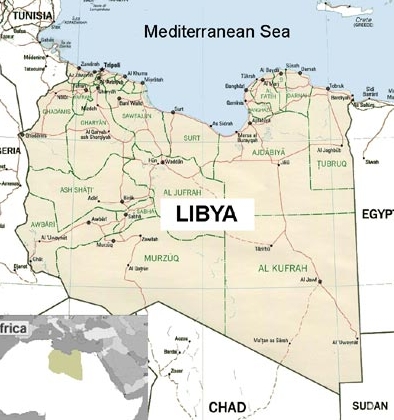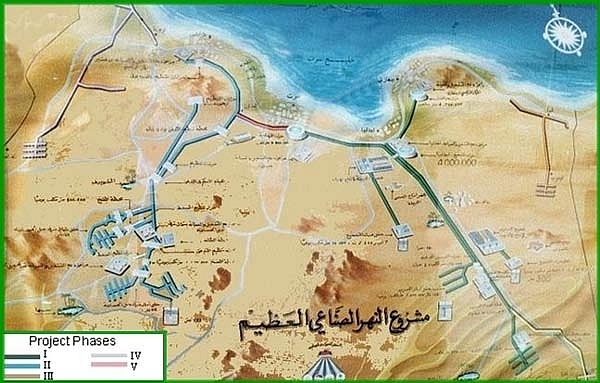|
|
GREAT MAN-MADE RIVER (GMR) WATER SUPPLY PROJECT, LIBYA
Contracts were awarded in 2001-02 for the next phase of Libya's Great
Man-Made River Project, an enormous, long-term undertaking to supply
the country's needs by drawing water from aquifers beneath the Sahara
and conveying it along a network of huge underground pipes.
In October 2001, the Great Man-Made River Authority (GMRA) awarded an
$82 million contract for the construction of major new pumping
facilities to a consortium led by Frankenthal KSB Fluid Systems. In
January the following year, the Nippon Koei / Halcrow consortium was
selected to provide the preliminary engineering and design works for
Phase III of the operation, worth $15.5 million.
The pumping station is scheduled to be completed in the summer of 2004
and KSB will subsequently be responsible for servicing the plant and
providing technical support for one year after completion. The
preliminary stages of phase III run until June 2005, though it is
anticipated that GMRA will invite tenders for the detailed design and
construction works towards the end of 2004.
When completed, phase III, which requires an additional 1,200km of
pipeline, will ultimately increase the total daily supply capacity of
the existing system to 3.68 million m³ and provide a further
138,000m³/day to Tobruk and the coast.
BACKGROUND
In 1953, the search for new oilfields in the deserts of southern Libya
led to
the discovery not only of the significant oil reserves, but also vast
quantities
of fresh water trapped in the underlying strata. The majority of this
water was
collected between 38,000 and 14,000 years ago, though some pockets are
only 7,000
years old.
There are four major underground basins. The Kufra basin, lying in the
south
east, near the Egyptian border, covers an area of 350,000km²,
forming an
aquifer layer over 2,000m deep, with an estimated capacity of
20,000km³ in the Libyan sector. The 600m-deep aquifer in the Sirt
basin
is estimated to hold over 10,000km³ of water, while the
450,000km² Murzuk basin, south of Jabal Fezzan, is estimated to
hold
4,800km³. Further water lies in the Hamadah and Jufrah basins,
which extend
from the Qargaf Arch and Jabal Sawda to the coast.
The GMR project - the world's largest engineering venture - is intended
to transport
water from these aquifers to the northern coastal belt, to provide for
the country's
5.6 million inhabitants and for irrigation. Intended to be the
showpiece of the
Libyan revolution, Colonel Moammar
Gaddafi called it the "eighth wonder of the world".
First conceived in the late 1960s, the initial feasibility studies were
conducted
in 1974 and work began ten years later. The project, which still has an
estimated
25 years to run, was designed in five phases. Each one is largely
separate in
itself but will eventually combine to form an
integrated system.
PHASES I AND II
The first and largest phase, providing 2 million m³/day along a
1,200km
pipeline from As-Sarir and Tazerbo to Benghazi and Sirt, via the
Ajdabiya reservoir,
was formally inaugurated in August 1991. This was a massive
undertaking, using
a quarter of a million sections of concrete pipe, 2.5 million t of
cement, 13
million t of aggregate, 2 million km of pre-stressed wire and requiring
85 million
m³ of excavation, for a
finished cost of $14 billion.
The Tazerbo wellfield consists of both production and piezometric
observation
wells and yields around 1 million m³/day at a rate of 120L/s per
well. Only
98 of the 108 production wells are used, with the others on stand-by. A
collection
network conveys the water to a
170,000m³ off-line steel header tank. From here, the main
conveyance system
is routed 256km to the north, to two similar header tanks at Sarir,
where the
second Phase I wellfield is located. A further 1 million m³ is
produced
here, using 114 of the 126 production wells, at an average flow rate of
102L/s
per well. The wells at both Tazerbo and Sarir are about 450m deep and
are equipped
with submersible pumps at a depth of
145m.
From Sarir, two parallel, 4m-diameter pipelines convey the now
chlorine-treated
water to the 4 million m³ Ajdabiya holding reservoir, 380km to the
north.
The water flows from this 900m-diameter reservoir through two
pipelines, one
heading west to Sirt and the other north to Benghazi. Each pipeline
discharges
into a circular earth embankment end reservoir, with a storage capacity
of 6.8
million m³ at Sirt and 4.7 million m³ at Benghazi, which have
been
designed to balance fluctuations in supply and demand. In addition,
large reservoirs
-
37 million m³ in the Sirt area and 76 million m³ in Benghazi
- have
been built to act as storage facilities for summer or drought
conditions.
Phase II delivers 1 million m³/day from the Fezzan region to the
fertile
Jeffara plain in the western coastal belt and also supplies Tripoli.
The system
starts at a wellfield at Sarir Qattusah, consisting of 127 wells
distributed
along three east-west collector pipelines and
ultimately feeds a 28 million m³ terminal reservoir at Suq El
Ahad.
PHASE III
Phase III falls into two main parts. Firstly, it will provide the
planned expansion
of the existing Phase I system, adding an additional 1.68
million m³/day along with 700km of new pipeline and new pumping
stations
to produce a final total capacity to 3.68 million m³/day.
Secondly, it will
supply 138,000m³/day to Tobruk and the coast from a new wellfield
at Al
Jaghboub. This will require the construction of a reservoir south of
Tobruk and
the laying of a further 500km of pipeline.
The preliminary engineering and design contract runs for 41 months and
includes
geotechnical and topographic surveys. The conceptual designs phase
features extensive
consideration of pipeline routing and profiling, hydraulics, pumping
stations,
M&E, control / communications system, reservoirs and other
structures, corrosion
control, power, operational support and maintenance provision. The
evaluation
of tenders for the
detailed design is expected in the first quarter of 2005.
The last two phases of the project involve the extension of the
distribution
network together with the construction of a pipeline linking the
Ajdabiya reservoir
to Tobruk and finally the connection at Sirt of the eastern and western
systems
into a single network.
When completed, irrigation water from the GMR will enable about
155,000ha of
land to be cultivated - echoing the Libyan leader's original prediction
that
the project would make the desert as green as the country's flag.

Map of Libya; the GMR project draws water from aquifers
beneath the Sahara
and conveys it along a network of
huge underground pipes to the coastal belt.

Schematic map of the project. Designed in five phases, which
eventually combine
to form an integrated system, it is
an estimated 25 years from completion.
|
Hydrokit Hydrology Modeling Software
Groundwater,
surface water and water quality modeling software - the Hydrokit series
Journal of Environmental Hydrology
The
world's first internet hydrology journal
HydroForum Discussion Group
Exchange
information with your colleagues
Free CD with IAEH Membership!
Join IAEH and get a free
modeling CD
Hydrology news - HydroNews past issues!
Up to date hydrology
jobs, meetings, new water technologies, and much more!
IAEH Puzzle?
Are you
a good hydrologist?
More Good Stuff
Fascinating odds and ends!
HydroLinks
Good places to visit
|


